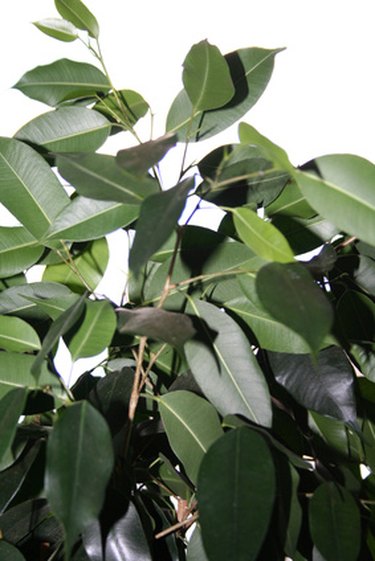
The ginseng fig is known by several names including the scientific names Ficus retusa and Ficus microcarpa and the common names ginseng ficus, pot-bellied ficus, Cuban-laurel, Chinese banyan, curtain fig and others. The swollen, twisted stem of the ginseng ficus makes it an attractive and unique houseplant or bonsai specimen. Some varieties thrive in warmer climates as trees or can be shaped into hedges or shrubs. Ficus can lose their leaves for a number of reasons.
Improper Light or Temperatures
Video of the Day
Poor light conditions can cause ficus to drop leaves. Ficus prefer high light conditions -- if there is inadequate available light, foliage may yellow and drop until the ficus has thinned enough to balance the foliage with available light. Move the ficus to a brighter area or use artificial plant lights to correct the issue. Ficus will be damaged by temperatures that remain below 40 degrees Fahrenheit for any period of time. The loss of green or immature leaves or leaves at branch tips may be indicative of low light conditions or drafts. This type of leaf loss may also be the result of overwatering.
Video of the Day
Change in Environment
Ficus often respond to even the slightest change in environment by losing some leaves. If the plant was recently moved and the temperature in the new location is not too low, monitor leaf drop to make sure it ceases within a few weeks. Additionally, monitor the soil drying rate in the new location and adjust the watering regimen as necessary to accommodate plant needs. Leaf drop can still persist for weeks after a problem has been corrected.
Improper Watering Practices
Ficus plants lose leaves if the plant is receiving too little or too much water. If the ficus is receiving too much water, it may lose green leaves, immature leaves or leaves at the tips of branches. Underwatered plants will drop bright yellow leaves. Ficus should be watered thoroughly. Soak the whole root mass and allow the water to drain from the base of the container. Only water when the surface of the soil is dry to the touch. Plants can be permitted to dry out more during winter months.
Fig Whitefly
Ficus trees, shrubs or plants grown outdoors in warm climates may be susceptible to the fig, or ficus, whitefly, a new and spreading pest in the United States. This insect feeds on the underside of leaves, causing yellowing, stunting, wilting, leaf drop and sometimes death. If the plant is disturbed, the adult whiteflies fly from the foliage. The fly looks like a small moth with a yellow body and white wings. Eggs or nymphs are generally found on the underside of leaves, which look as though they are dotted with small white or silver spots.
Additional Pests
Blister leaf gall first arrived in Florida in 2007. This leaf gall is caused by a small wasp that creates a series of bumps on leaves where the female wasp has inserted eggs that receive nourishment from plant tissue. Severe infestations of other insects or mites may result in leaf drop. Check the ficus for other symptoms or indications of pest presence, diagnose the pest and treat the ginseng ficus accordingly.
- North Dakota State University Extension; Questions on Ficus; Ron Smith
- University of Florida IFAS Extension; The Fig Whitefly; Catharine Mannion, et al.; August 2008
- University of Florida IFAS Extension; Ficus Trees Under Severe Insect Attack!; Doug Caldwell; 2008
- University of Florida IFAS Extension; Nutrient Deficiency Symptoms...; T. Broschat; March 2008